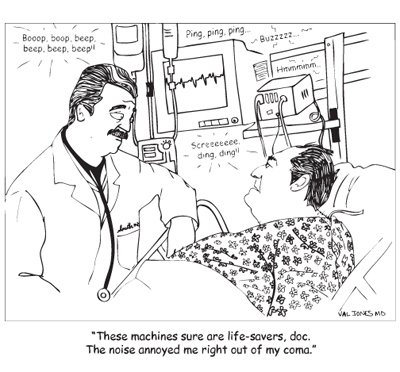July 15th, 2009 by Medgadget in Better Health Network, Expert Interviews, Health Policy, News
No Comments »

A team at Johns Hopkins has coordinated the world’s largest kidney swap, involving sixteen patients in multiple medical centers across the US. One of the donors was the vice president of human resources at Johns Hopkins Health System, a woman who has promoted organ donation and finally got a chance to do the ultimate charity work herself.
Johns Hopkins reports:
An altruistic donor started the domino effect. Altruistic donors are those willing to donate a kidney to any needy recipient. Just like falling dominoes, the altruistic donor kidney went to a recipient from one of the incompatible pairs, that recipient’s donor’s kidney went to a recipient from a second pair and so on. The last remaining kidney from the final incompatible pair went to a recipient who had been on the United Network for Organ Sharing (UNOS) waiting list.
As part of this complex procedure, Johns Hopkins flew one kidney to Henry Ford, one kidney to INTEGRIS Baptist and one kidney to Barnes-Jewish, In exchange, Henry Ford, INTEGRIS Baptists and Barnes Jewish each flew a kidney to Johns Hopkins.
The 16 surgeries were performed on four different dates, June 15, June 16, June 22 and July 6. The 10 surgeons in charge included four at Johns Hopkins, two at INTEGRIS Baptist, two at Barnes-Jewish and two at Henry Ford.
Johns Hopkins surgeons performed one of the first KPD transplants in the United States in 2001, the first triple-swap in 2003, the first double and triple domino transplant in 2005, the first five-way domino transplant in 2006 and the first six-way domino transplant in 2007. Johns Hopkins also performed the first multihospital, transcontinental three-way swap transplant in 2007 and the first multihospital, transcontinental six-way swap transplant in 2009.
Nearly 100 medical professionals took part in the transplants, including immunogeneticists, anesthesiologists, operating room nurses, nephrologists, transfusion medicine physicians, critical care doctors, nurse coordinators, technicians, social workers, psychologists, pharmacists, financial coordinators and administrative support people.
*This blog post was originally published at Medgadget*
July 5th, 2009 by Medgadget in Better Health Network
No Comments »


A team of Canadian researchers analyzed the air traffic patterns during March and April of this year, looking for correlation between departure/arrival cities of passengers and the spread of H1N1 swine-origin influenza. Turns out that the two are closely correlated and confirm that airports are gateways of pathogens as well as vacationing tourists.
Our analysis showed that in March and April 2008, a total of 2.35 million passengers flew from Mexico to 1018 cities in 164 countries. A total of 80.7% of passengers had flight destinations in the United States or Canada; 8.8% in Central America, South America, or the Caribbean Islands; 8.7% in Western Europe; 1.0% in East Asia; and 0.8% elsewhere. These flight patterns were very similar to those during the same months in 2007 (see Fig. 1 in the Supplementary Appendix). We then compared the international destinations of travelers departing from Mexico with confirmed H1N1 importations associated with travel to Mexico, and we found a remarkably strong degree of correlation. Of the 20 countries worldwide with the highest volumes of international passengers arriving from Mexico, 16 had confirmed importations associated with travel to Mexico as of May 25, 2009. A receiver-operating-characteristic (ROC) curve plotting the relationship between international air-traffic flows and H1N1 importation revealed that countries receiving more than 1400 passengers from Mexico were at a significantly elevated risk for importation. With the use of this passenger threshold, international air-traffic volume alone was more than 92% sensitive and more than 92% specific in predicting importation, with an area under the ROC curve of 0.97.
Letter to NEJM: Spread of a Novel Influenza A (H1N1) Virus via Global Airline Transportation
*This blog post was originally published at Medgadget*
June 30th, 2009 by Medgadget in Better Health Network
No Comments »

 Wooden legs sure have come a long way since they were first used as artificial prostheses. In the latest issue of Journal of Materials Chemistry, there is a report on the recent developments at the Institute of Science and Technology for Ceramics in Italy in which scientists have turned wood into something similar to bone, a material that may one day be used to create custom replacement parts.
Wooden legs sure have come a long way since they were first used as artificial prostheses. In the latest issue of Journal of Materials Chemistry, there is a report on the recent developments at the Institute of Science and Technology for Ceramics in Italy in which scientists have turned wood into something similar to bone, a material that may one day be used to create custom replacement parts.
Researchers heated the wood to decompose organic material to leave only the carbon template. Then, they reacted the template with calcium, oxygen, and carbon dioxide to form calcium carbonate that was then converted to hydroxyapatite. This hydroxyapatite scaffold mimics the structure of bone. The advantage of this process is the architectural make-up of the wood’s structure that affords the ability of cells and blood vessels to grow through it, much like real bone.

‘Current [hydroxyapatite] production processes do not generate an organised hierarchical structure,’ says Anna Tampieri. ‘Materials able to maintain adequate properties at extremely high temperatures and mechanical stress are highly sought after for use in several different applications, such as space vehicles. An intriguing possibility is that of simultaneously achieving high values of strength and toughness, for which ordinarily there is a trade-off. In addition, new materials with extreme physical properties, such as thermal expansion or piezoelectricity, can be obtained.’
More from the Journal of Materials Chemistry : Trees take on tissue engineering; From wood to bone: multi-step process to convert wood hierarchical structures into biomimetic hydroxyapatite scaffolds for bone tissue engineering…
*This blog post was originally published at Medgadget*
June 22nd, 2009 by Medgadget in Uncategorized
No Comments »


SonoSite just released their SonoRemote for controlling the company’s M-Turbo and S Series ultrasounds during interventional procedures like joint injections or central line placements. In addition to traditional style buttons, the remote control features voice recognition and can be programmed to understand commands in any language. So now you can hold the probe in one hand and the syringe in the other, and not have to fiddle with reaching over to the unit to take snapshots or change parameters.

Voice or touch activated
Programmable to your voice and language
Adjust system controls from a radius of 10 meters
No need to break the sterile field
Drop-tested to 3 feet
Works with M-Turbo® and S Series™
Press release: SonoSite Begins Customer Shipments Of Ultrasound Remote Control
Product page: SonoRemote
Flashbacks: M-Turbo™: New Portable Ultrasound from SonoSite ; SonoSite S-ICU™ Ultrasound Tool; S-Nerve™ from SonoSite; The SonoSite® MicroMaxx™; Titan

*This blog post was originally published at Medgadget*
June 18th, 2009 by Medgadget in Better Health Network
No Comments »

 Directly imaging dynamic biomolecular processes can reveal secrets which scientists have been trying to uncover in indirect ways. The interaction between various virus species and the immune system is one of those topics that would benefit from novel visualization techniques. Now researchers from the Howard Hughes Medical Institute have imaged, with considerable detail, a rotavirus as it is grabbed by an immune system molecule. The technique may allow the development of better vaccines against not only rotavirus, but open a large range of research possibilities in the life sciences.
Directly imaging dynamic biomolecular processes can reveal secrets which scientists have been trying to uncover in indirect ways. The interaction between various virus species and the immune system is one of those topics that would benefit from novel visualization techniques. Now researchers from the Howard Hughes Medical Institute have imaged, with considerable detail, a rotavirus as it is grabbed by an immune system molecule. The technique may allow the development of better vaccines against not only rotavirus, but open a large range of research possibilities in the life sciences.
In the new experiments, Howard Hughes Medical Institute (HHMI) researchers have mapped the structure of an antiviral antibody clamped onto a protein called VP7 that stipples the surface of rotavirus. The structural map reveals intimate new details about how the antibody interferes with VP7, a protein that helps the virus infect cells. The information may be useful in designing a new generation of rotavirus vaccines that could be easier to store and administer than current vaccines, said the researchers.
Rotaviruses replicate mainly in the gut, where they infect cells in the small intestine. The virus has a triple-layered protein coat, which allows it to resist being chewed up by digestive enzymes or the gut’s acidic environment. Rotavirus does not have an envelope covering its protein shell. A virus’ envelope helps it enter host cells, and viruses without envelopes face significant hurdles in penetrating the membrane of the cells they infect. “Since they have no membrane of their own, they must therefore perforate a cellular membrane to gain access to the cytoplasm (the interior of the cell),” [HHMI investigator Stephen C. Harrison] said.
The new research shows that as rotavirus matures inside an infected cell, it assembles a kind of “armor” coating made principally of VP7 and a “spike” protein called VP4. When the mature virus particle exits one cell to infect a new cell, it perforates the endosomal membrane of the target cell by thrusting in its VP4 spike like a grappling hook.
The virus’ ability to infect cells depends on a critical structural change that quickly removes the coat from the interconnected VP7 proteins — an event that unleashes the spike protein. Although researchers still do not know precisely what triggers the uncoating of VP7, they do know that it appears to happen when the virus senses a lowered concentration of calcium in its environment.
“VP7 sort of closes over VP4 locking it in place like the metal grills that surround a tree planted on a city sidewalk,” explained Harrison. “And it is the loss of VP7 in the uncoating step that triggers VP4 to carry out its task.”
To get a closer look at how antibodies latch onto VP7 and neutralize the virus, Harrison and his colleagues used x-ray crystallography to examine the molecular architecture of VP7 in the grasp of a fragment of the antibody. X-ray crystallography is a powerful tool for “seeing” the orientation of atoms and the distances separating them within the molecules.
Before Harrison’s team could use x-ray crystallography, however, they first had to crystallize VP7 in complex with the antibody fragment. Only after that step was completed, could they move on to bombarding those crystallized proteins with x-rays. Computers helped capture the diffraction patterns that emerged as the x-rays scattered from the crystal lattice. By rotating the crystallized protein complexes through multiple exposures, the researchers could record enough data to calculate three-dimensional models, which exposed the underlying architecture of VP7 and the antibody fragment.
The resulting detailed structural map of the VP7-antibody protein complex revealed that the antibody neutralizes the virus by preventing the VP7 proteins from dissociating, said Harrison. “Normally, calcium creates a bridge between VP7 molecules that holds them in place until uncoating,” he said. “Our structure revealed that the antibody makes an additional bridge, cementing the subunits together, making the virus resistant to the uncoating trigger and preventing it from infecting cells.”
Current rotavirus vaccines consist of weakened live virus that triggers the immune system to produce neutralizing antibodies. However, the new structural findings suggest how researchers might engineer a different type of rotavirus vaccine consisting only of immune-triggering protein, said Harrison. This protein-only vaccine could be made of a chemically linked complex of VP7 molecules that would stimulate the immune system more vigorously to produce anti-rotavirus antibodies.
While live-virus-based vaccines have been effective, said Harrison, they have drawbacks that a protein-based vaccine might overcome. The virus-based vaccines are perishable and require refrigeration, but vaccines based on proteins are more stable and can be stored at room temperature. Another benefit, said Harrison, is that protein-based vaccines could be combined with other protein vaccines in a “cocktail” that would cut down on the number of clinic visits since blending cannot be done so readily with virus-based vaccines. These advantages could make protein vaccines especially useful in developing countries that lack an extensive public health infrastructure and where the vast majority of childhood deaths from rotavirus occur, Harrison said.
HHMI press release: New Images May Improve Vaccine Design for Deadly Rotavirus
Abstract in Science: Structure of Rotavirus Outer-Layer Protein VP7 Bound with a Neutralizing Fab
*This blog post was originally published at Medgadget*




 Wooden legs sure have come a long way since they were first used as artificial prostheses. In the latest issue of Journal of Materials Chemistry, there is a report on the recent developments at the Institute of Science and Technology for Ceramics in Italy in which scientists have turned wood into something similar to bone, a material that may one day be used to create custom replacement parts.
Wooden legs sure have come a long way since they were first used as artificial prostheses. In the latest issue of Journal of Materials Chemistry, there is a report on the recent developments at the Institute of Science and Technology for Ceramics in Italy in which scientists have turned wood into something similar to bone, a material that may one day be used to create custom replacement parts.


 Directly imaging dynamic biomolecular processes can reveal secrets which scientists have been trying to uncover in indirect ways. The interaction between various virus species and the immune system is one of those topics that would benefit from novel visualization techniques. Now researchers from the Howard Hughes Medical Institute have imaged, with considerable detail, a rotavirus as it is grabbed by an immune system molecule. The technique may allow the development of better vaccines against not only rotavirus, but open a large range of research possibilities in the life sciences.
Directly imaging dynamic biomolecular processes can reveal secrets which scientists have been trying to uncover in indirect ways. The interaction between various virus species and the immune system is one of those topics that would benefit from novel visualization techniques. Now researchers from the Howard Hughes Medical Institute have imaged, with considerable detail, a rotavirus as it is grabbed by an immune system molecule. The technique may allow the development of better vaccines against not only rotavirus, but open a large range of research possibilities in the life sciences.







